Chatbot vs Live Chat: Which is Right for Your Business?
Chatbots vs live chat: Both communication channels create a unique customer experience for users by providing quick answers, so they don’t have to wait for an email or jump on the phone.
Modern-day businesses are rapidly shifting from transactional to conversational relationships. Artificial intelligence (AI) has transformed the way businesses interact and engage with customers. The emergence of chatbots empowers businesses with innovative ways of strengthening customer relationships.
Marketing experts predict that “85% of consumers will be able to manage their relationships with brands without human interaction”.
As per Oracle, 80% of businesses want chatbots as they are beginning to see the benefits of using chatbots for their customer-based products. So, if given a choice between chatbot vs live chat, what would you choose to deliver superior customer service?
Let us explore the key differences between chatbots and live chat and help you determine which option is best suited for your business.
Chatbots are defined as computer programs designed to simulate conversation with human users. They are powered by artificial intelligence (AI) and can be integrated into messaging platforms, websites, or applications.
Chatbots use natural language processing (NLP) algorithms to understand and interpret user inputs, allowing them to generate appropriate responses.
The key features of AI-enabled bots mentioned below help to improve customer experience.
Bots can engage customers across websites, applications, and messaging apps such as Facebook Messenger or WhatsApp. Bots offer numerous benefits that can enhance customer experience and streamline business operations.
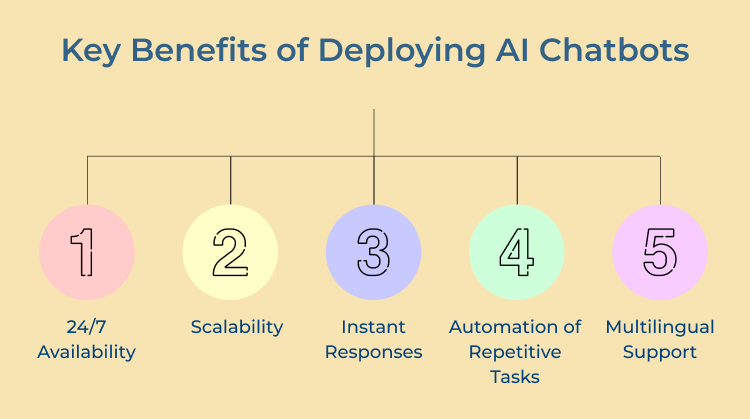
Here are the reasons why chatbots are beneficial:
Chatbots can provide round-the-clock assistance, unlike human support representatives. It ensures that customers can reach out for support at any time, improving customer satisfaction and reducing response time.
Chatbots can be easily scaled during peak business hours or specific occasions to meet any volume of requests effectively. It helps to meet customer queries in real time delivering a superior customer service experience.
Chatbots are designed to provide immediate responses to all sales and support queries. Customers no longer have to wait in long queues or deal with frustrating support helplines. They can receive immediate assistance by interacting with the bot.
Chatbots excel at automating repetitive tasks, such as answering frequently asked questions or processing routine transactions. Automation allows human employees to focus on more complex and value-added tasks.
Having the ability to be programmed in multiple languages, chatbots cater to a diverse customer base and bridge language barriers, enabling businesses to expand their global reach.
Live chat refers to the real-time communication platform that allows businesses to engage with their customers directly through their website or application. It enables instant messaging between customers and support reps, providing an efficient way to address queries.
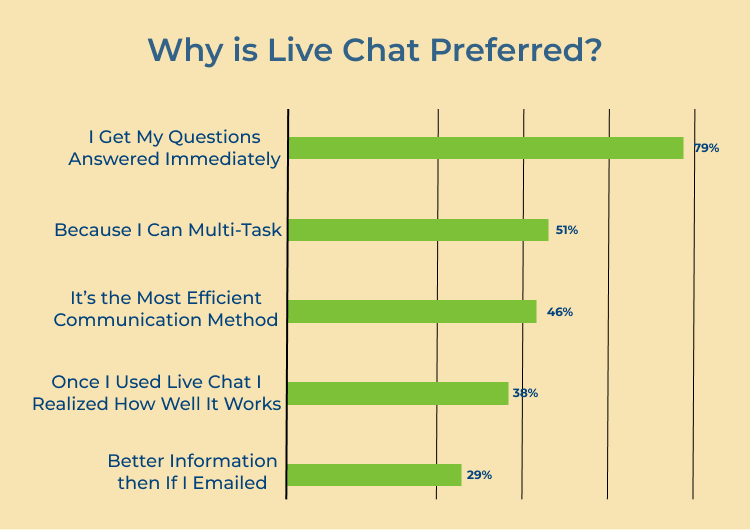
The key objectives of implementing live chat:
Live chat is becoming an increasingly popular feature on websites and for good reason. It offers a convenient and efficient way for businesses to connect with their customers in real-time.

Here are the reasons why live chat is so advantageous:
Deploying live chat helps customers to receive real-time troubleshooting assistance from knowledgeable support agents. They can even share screens or exchange files, making it easier to diagnose and resolve complex issues.
Implementing live chat enables customer service agents to handle multiple chat conversations simultaneously, increasing efficiency and productivity. It ensures that customers don’t have to wait in long queues and receive timely responses.
Live chat transcripts can provide valuable insights into customer preferences, pain points, and frequently asked questions. The information can then be used to improve products and services, optimize marketing strategies to enhance the overall customer experience.
Live chat software often includes features like proactive chat invitations, which allow businesses to reach out to website visitors and engage them in a conversation. It not only increases website engagement but also improves the chances of converting visitors into customers.
Chatbot vs live chat: the two popular options that have revolutionized how businesses interact with customers. Both software serve as valuable tools for interacting with customers and providing real-time assistance, but they possess significant differences that are important to understand.
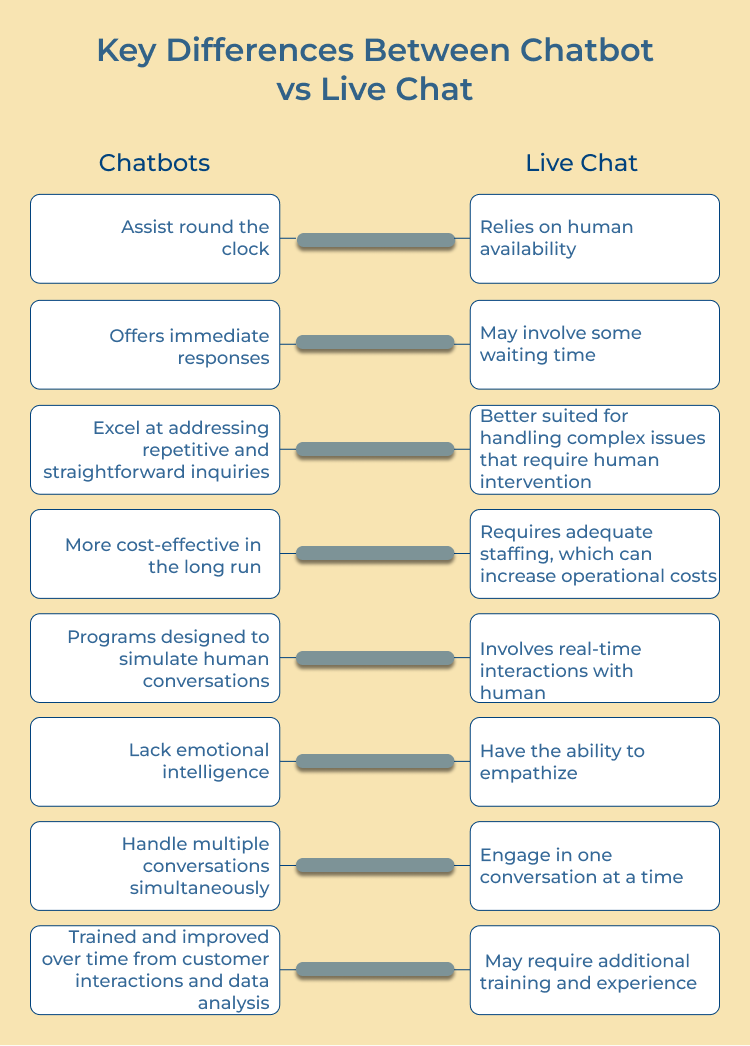
Let’s dive into the key differences between chatbots and live chat.
Live chat relies on human availability, which means it may not be available 24/7. Chatbots can provide assistance round the clock, ensuring constant availability and faster responses.
AI chatbots offer immediate responses, using pre-programmed answers to address common queries. While live chat involves waiting time, as representatives handle one conversation at a time.
Live chat is better suited for handling complex issues that require human intervention and problem-solving skills. Chatbots excel at addressing repetitive and straightforward inquiries, eliminating the need for human intervention in routine tasks.
Chatbots can be more cost-effective in the long run, as businesses do not have to employ a team of customer service representatives. Live chat requires adequate staffing, which can increase operational costs.
The fundamental difference between chatbots and live chat is the level of automation. Chatbots are computer programs designed to simulate human conversations, while live chat involves real-time interactions with human customer service representatives.
While chatbots are constantly evolving, they may still struggle with understanding slang, contextual nuances, or complex queries. Live chat offers the advantage of human language comprehension, allowing for more effective communication.
Human staff have the ability to empathize, understand emotions, and provide personalized support based on the customer’s sentiments. Chatbots lack emotional intelligence and fail to provide the same level of understanding & empathy.
Chatbots can handle multiple conversations simultaneously, making them ideal for businesses with high customer volume. Live chat requires human representatives to engage in one conversation at a time, limiting scalability.
Live chat allows for personalized interactions as human agents can tailor their responses based on the specific needs and preferences of the user. Chatbots are capable of basic personalization but lack the human touch to understand complex emotions or contexts.
Chatbots can be trained and improved over time as they learn from customer interactions and data analysis. It enables them to become more efficient in responding to queries. Live chat agents can also learn and improve, but it may require additional training and experience.
User preference is a crucial factor to consider. Some users prefer the convenience and speed of chatbots, while others appreciate the human touch and personalized assistance provided by live chat. Understanding your target audience and their preferences will help you make an informed choice.
Both live chat and chatbot are predominant channels used by businesses to assist and engage customers. Both tools can also work well together. Choosing between both the software for your business can be a challenging decision. Both have their pros and cons so it’s important to carefully consider your specific needs and priorities before making a choice.
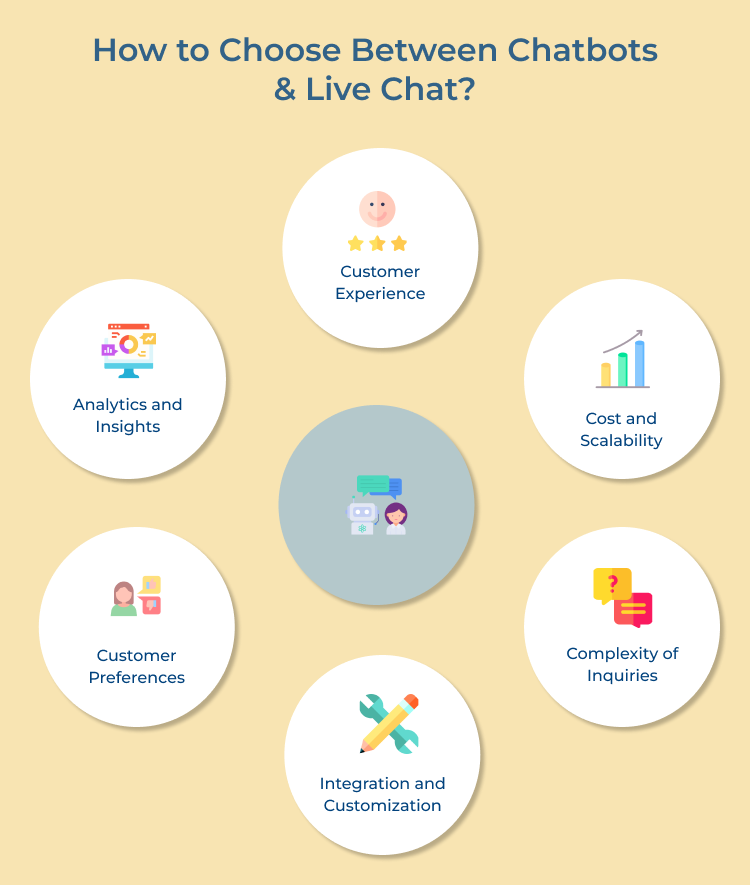
Here are some factors to consider when choosing between chatbots and live chat:
Consider the type of experience you want to provide to your customers.
Live chat allows for real-time, personalized interactions with a human representative, which can create a more engaging and dynamic experience. Chatbots offer 24/7 availability and quick responses, which can be convenient for customers who prefer self-service.
Here are some pro tips for making the choice:
Chatbots are generally more cost-effective and scalable compared to live chat. Once a chatbot is set up, it requires minimal maintenance and can handle multiple customer inquiries simultaneously.
Live chat requires human resources to be available around the clock and may become expensive as your business grows.
Here are some pro tips for making the choice:
Consider the complexity of the inquiries that your customers typically have. If your business deals with simple and straightforward queries, a chatbot can efficiently handle these repetitive tasks.
Customers often have complex or unique questions, live chat with trained representatives may be better equipped to provide accurate and personalized solutions.
Here are some pro tips for making the choice:
Evaluate your business systems to determine how well chatbots and live chat can integrate with your existing platforms. Chatbots can be seamlessly integrated with various channels &CRMs to facilitate automated responses and data collection.
Live chat may require more complex integrations and customization to align with your existing workflows.
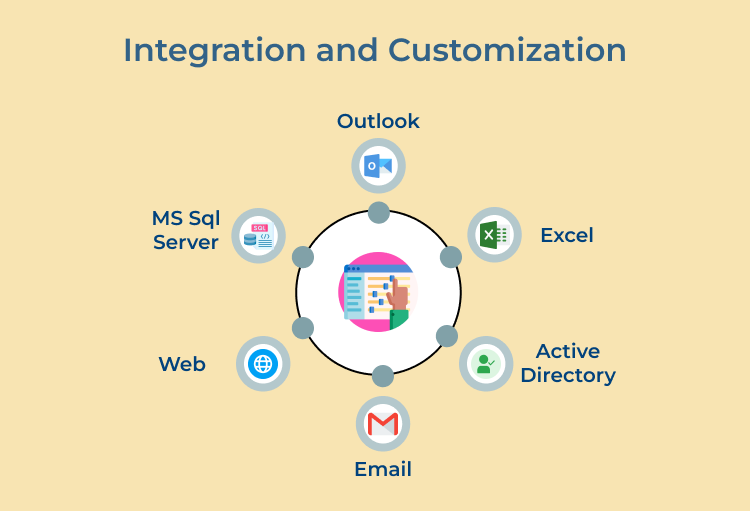
Here are some pro tips for making the choice:
Consider your target audience and their preferences. Some customers may prefer convenience and speed, while others may value the human touch & personalized assistance.
Conducting surveys or collecting feedback can help you understand your customers’ preferences and make an informed decision. Understanding your target audience: Analyze their preferences and align your customer service channel accordingly.
Here are some pro tips for making the choice:
Both chatbots and live chat provide valuable data & insights that can help improve your customer service and marketing strategies.
Chatbots can generate reports on frequently asked questions and customer behavior. But live chat can provide real-time feedback and qualitative insights. Consider which type of data is most important for your business and choose accordingly.
Here are some pro tips for making the choice:
Chatbots and live chat are both essential tools in the world of customer service and support. While chatbots offer convenience and automation, live chat provides a human touch and personalized assistance. Finding the right balance between chatbots and live chat is crucial for businesses aiming to deliver exceptional customer support.
Understanding the strengths & limitations of each tool, analyzing customer preferences and designing an intuitive user experience helps businesses strike that delicate balance and provide a personalized, efficient & satisfying customer experience.
Why are Chatbots Important?
Chatbots are important because they provide businesses with an efficient and effective way to engage with customers. They are designed to simulate human conversations and can handle multiple inquiries simultaneously. It saves businesses time , allowing them to provide instant responses to customer queries and enhance customer satisfaction.
Why do some businesses prefer to use chatbots instead of live chat systems?
There are several reasons why businesses prefer chatbots over live chat systems. Chatbots are available 24/7 and can handle a large volume of inquiries simultaneously, ensuring prompt customer support at all times. Chatbots can be more cost-effective for businesses as they don’t require a large team of customer service representatives to operate.
What are the advantages of using live chat over chatbots in customer service?
Live chat systems, on the other hand, provide businesses with a human touch in customer interactions. They are ideal for complex queries that may require a personalized response or emotional support. Live chat enables businesses to build a personal connection with their customers, fostering trust and loyalty.
Why is chatbot better than live chat?
Chatbots are better than live chat in certain situations. They offer instant responses and can handle a large number of inquiries simultaneously, providing immediate assistance to customers. Chatbots also eliminate human error in responses and provide consistent information to customers. Bots can be programmed to remember customer preferences and history, offering a personalized experience.
Are chatbots accurate?
Chatbots are only as accurate as the information and programming they are provided with. They rely on pre-set responses and algorithms to provide answers to inquiries. While they can handle simple and frequently asked questions accurately, they may struggle with complex or unexpected queries. Advancements in technology, such as natural language processing, have significantly improved chatbot accuracy and capability to understand and respond to customer queries.